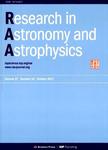NSVS 01286630:a detached binary with a close-in companion
NSVS 01286630:a detached binary with a close-in companion作者机构:Yunnan ObservatoriesChinese Academy of SciencesKunming 650216China Key Laboratory of the Structure and Evolution of Celestial ObjectsChinese Academy of SciencesKunming 650216China University of Chinese Academy of SciencesBeijing 100049China School of Physics and Electronic ScienceGuizhou Normal UniversityGuiyang 550001China
出 版 物:《Research in Astronomy and Astrophysics》 (天文和天体物理学研究(英文版))
年 卷 期:2018年第18卷第9期
页 面:123-132页
核心收录:
学科分类:07[理学] 070401[理学-天体物理] 0704[理学-天文学]
基 金:supported by the National Natural Science Foundation of China(Nos.11573063,11611530685) the Key Science Foundation of Yunnan Province(No.2017FA001) support from the staff of the Xinglong 85 cm telescope partially supported by the Open Project Program of the Key Laboratory of Optical Astronomy,National Astronomical Observatories,Chinese Academy of Sciences
主 题:stars binaries close- stars binaries eclipsing-stars individual (NSVS 01286630)
摘 要:New photometric observations of NS VS 01286630 were performed and two sets of fourcolor(B, V, Rc, Ic) light curves(LCs) were obtained. Using the 2013 version of the Wilson-Devinney(W-D) code, we analyzed these data. The photometric solutions reveal that NS VS 01286630 is an active detached eclipsing binary(EB) with a high orbital inclination(nearly 90°). Remarkably, the temperature of the primary component(the hotter star) is higher than the secondary one, but the value of mass ratio q(M2/M1)for NS VS 0128663 is more than 1, which can be explained in that the surface of the secondary component of NSVS 01286630 is covered with big cool starspots. Based on our new CCD mid-eclipse times and the data published until now, variations in the mid-eclipse times were reanalyzed in detail using a weighted least-squares method. It is discovered that the(O-C) diagram of the system shows a cyclic oscillation with a period of 3.61 yr and an amplitude of 0.001 d. The cyclic variation may be caused by the light-travel time effect(LTTE) due to the presence of a third companion, whose mass we calculated as M3 sin(i3) =0.11 M(⊙). The third body may affect the orbital evolution of the central binary system by transferring angular momentum.



